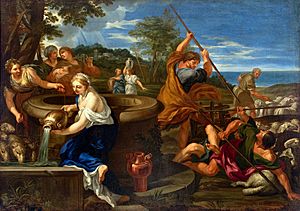Ciro Ferri facts for kids

Ciro Ferri (born 1634 – died 1689) was a talented Italian artist from the Baroque period. He was both a sculptor and a painter. Ciro Ferri was the main student and later the successor of a very famous artist named Pietro da Cortona.
Early Life and Training
Ciro Ferri was born in Rome, Italy. He began his art career working with Pietro da Cortona. Together, they worked on large fresco paintings at the Quirinal Palace in Rome between 1656 and 1659. Frescoes are paintings done on wet plaster walls.
Ferri also helped Cortona with many frescoed ceilings and other decorations. These were for the Pitti Palace in Florence, from 1659 to 1665.
Important Artworks
One of Ciro Ferri's most important works is a large series of religious frescoes. You can find these beautiful wall paintings in the church of Basilica di Santa Maria Maggiore (Bergamo).
He also painted a well-known altarpiece. This is a large painting for an altar in a church. It is called St Ambrose Healing the Sick and is in the church of Sant'Ambrogio della Massima in Rome.
In 1670, Ferri started painting the inside of the dome of Sant'Agnese in Agone. This church is in central Rome. He worked in a style similar to Giovanni Lanfranco's art. Sadly, Ciro Ferri died before he could finish this big project. His student, Sebastiano Corbellini, completed it in 1693.
Beyond Painting
Ciro Ferri was a very versatile artist. He created many different designs. This included etchings, which are a type of printmaking. He also designed front pages for books. Ferri even worked as an architect, designing buildings.
In 1657, Ciro Ferri became a member of the Accademia di San Luca. This was an important art academy in Rome. His work for the high altar of Santa Maria in Vallicella is a masterpiece. It is a ciborium, which is a canopy over an altar, made of bronze.
Ferri also helped lead the Medici Academy in Rome. This academy was for Florentine art students. It was started in 1673 by Grand Duke Cosimo III de' Medici of Tuscany. Ferri led this academy along with the sculptor Ercole Ferrata.
Other Contributions
Ciro Ferri created the Reliquary of the Arm of St. John the Baptist. This important religious object is found in the St John's Co-Cathedral in Malta.
He also contributed five illustrations to a special book called a missal. This missal belonged to Pope Alexander VII Chigi and was published in 1662. Other famous artists in Rome also contributed to this book. These included Pietro da Cortona, Carlo Cesi, and Carlo Maratti.
Ciro Ferri passed away in Rome in 1689.
See also
 In Spanish: Ciro Ferri para niños
In Spanish: Ciro Ferri para niños

